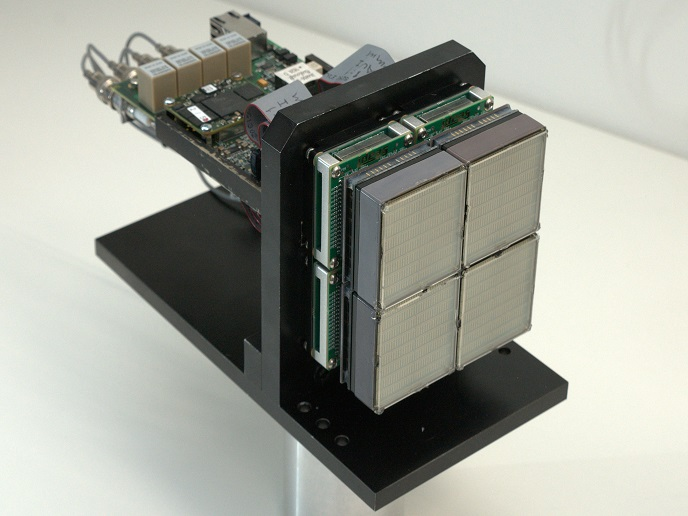
Solid-State Neutron Detectors Project (SoNDe) 6-Lithium Enriched Glass Scintillators for High-Flux Neutron Radiography
Scintacor is proud to have participated in this exciting project with Dr Ralf Engels and the Jülich Centre for Neutron Science to provide Li-6 glass scintillators for the novel neutron scattering detector for bright neutron beams.
The Solid-State Neutron Detector – SoNDe – project aims to develop a high-resolution neutron detector technique that will enable the construction of position-sensitive neutron detectors for high-flux sources, such as the upcoming European Spallation Source (ESS) by avoiding the use of 3He in this detector the 3He-shortage, which might otherwise impede the construction of such large-scale facilities. Replacing 3He, Scintacor’s 6-lithium glass scintillators have been used in the SoNDe project to create a novel high-efficiency neutron detector with the capability to clearly distinguish between neutrons and gamma radiation.
Neutron Detection
Scintacor and its precursors have been involved with the production of 6-lithium enriched glass scintillators since 1958 (then Levy West Laboratories) when it started manufacturing these glasses with various compositions based on the work by Anderson et al. Today Scintacor is the owner of the GS20® trademark and a trusted partner of many leading research organizations and commercial customers that have chosen GS20® and the companion formulations for their unique properties, mechanical robustness, gamma / neutron discrimination, high sensitivity to thermal neutrons, the temperature range of use -200 to 250 C and resistance to all organic and inorganic solvents except hydrofluoric acid.
Example applications:
- Radiation Portal Monitors (RPM) to detect illicit trafficking in radioactive materials whether by a person, in cargo, or in a motor vehicle or train,
- Portable Radiation Monitors to allow first responders to detect sources of gamma and neutron radiation and distinguish neutron sources such as plutonium from gamma sources. This technology helps to protects against the threat of radiation and radioactive material with real-time detection and immediate results,
- Oil and gas exploration – Scintacor’s GS20® glass has been adopted as the technology of choice for downhole neutron-porosity logging tools, due to the ability to withstand high temperature and high shock environments. This characteristic is essential when porosity measurements are performed during drilling when the tools are subjected to the high levels of vibration and heat generated by the drilling activity.

The European Spallation Source
At the heart of the ESS will be a 600-meter linear accelerator that fires protons at a tungsten target, from which neutrons will be consequently emitted. It will use neutrons to probe the structure and movement of various materials on an atomic/molecular level to enable scientific analysis. Its construction requires significant technological advances on all fronts of instrument component design. Detectors are no exception. Such new sources exceed the capabilities of current neutron detectors in their ability to measure high rates of particles emitted or to detect the positions of particles in the space with high precision – or both. To this end, the initially very bright neutron beam emitted from a powerful neutron source often has to be attenuated.
First modular solid-state detector for high-neutron fluxes
The Solid-State Neutron Detector Project (SoNDe) pioneered the design of a scintillation detector that eliminates the need to attenuate the neutron beam. “SoNDe uses a modular detector design that allows scientists to count up to 250 000 neutrons per second using a single 5×5 cm2 module. This makes the detector over 20 times more capable than state-of-the-art neutron detectors. Each module can be used independently or put together with other detectors in whatever arrangement is required,” explains Jaksch. Neutrons first hit the Ce-activated 6-lithium glass scintillators. 6-lithium is a stable lithium isotope that emits a triton and an alpha particle when a thermal neutron interacts with it causing a nuclear reaction. The emission of these particles then causes a weak flash of light allowing the nuclear reaction to be detected optically, for example with a photomultiplier. Approximately 600 photons are emitted for each neutron captured. Jaksch explains that “with SoNDe, we have the dynamic range to distinguish whether 1 or 250 000 neutrons are emitted per second. The photomultiplier helps us detect both very weak and strong signals to measure their strength correctly.” The project team tapped into the potential of multiple-anode photomultiplier tubes that behave like many detectors in one, where each single pixel acts like a photomultiplier. Thanks to its much smaller diameter, it can accommodate more sensors on the surface, thus improving the detector count rate and resolution. Another main advantage of the new neutron detector technology is that the scintillator does not contain helium-3, a rare and expensive gas.
Peeking at the future
Highly efficient neutron detectors are critical in many sectors, including materials science, medicine, biology and astronomy. “Tracking the transport of drug molecules with neutrons helps develop better means of drug delivery, where large quantities can be targeted to the appropriate sites in the body. They can also offer archaeologists significant and otherwise wholly inaccessible insight into ancient artefacts without destroying or cutting them,” notes Jaksch. Another application is the investigation of high-performance batteries in operation, such as are needed for electric vehicles. Besides scientific research, such detector technologies open up new practical applications and can be adapted to suit those applications. “Self-driving cars will need suitable detectors to find obstacles, to measure the speed of other vehicles and navigate the road safely. Finally, SoNDe detector technology may also prove useful in helping detect turbulences during flights,” concludes Jaksch.
Forschungszentrum Jülich Centre for Neutron Science, Dr Ralf Engels Reference Article
Find out more about Scintacor 6-lithium-glass for neutron detection or contact our sales team to discuss your requirements.

